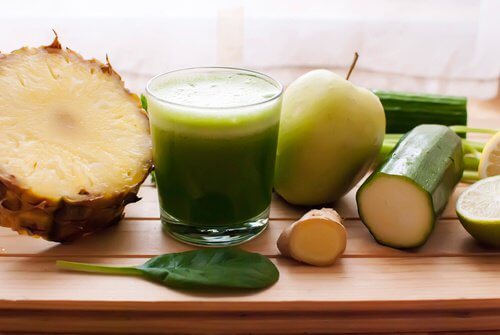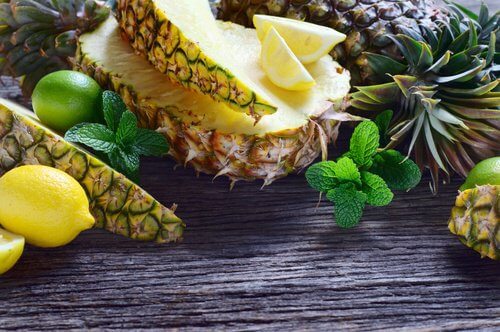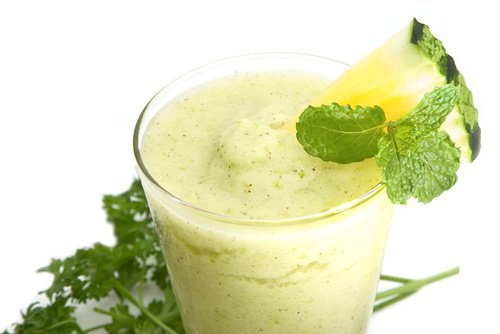Reduce Belly Fat with This Pineapple, Cucumber, Celery, Ginger, and Lemon Juice

Several preparations have the following label: Reduce belly fat! that can be a good supplement to your diet and a suitable substitute for the unhealthy foods and drinks that you tend to snack on when you’re craving something.
Among these preparations, you’ll find delicious juices and smoothies. In addition to helping to hydrate your body, they quench your appetite and, in a way, also help to reduce belly fat.
Below, we’ll present the recipe for a pineapple, cucumber, celery, ginger, and lemon juice. This is an extremely refreshing and delicious combination that’s suitable for any season the year!
Belly fat, a headache
Belly fat is a headache for people around the world. Not only does it not allow you to look good, but it also doesn’t let your health be at 100%. For this reason, many work hard to reduce it.
Belly fat appears as a consequence of bad lifestyle habits, especially a sedentary lifestyle and an unbalanced diet rich in refined flours, saturated fats, sugars, and others.

But accomplishing this isn’t easy. Many find it difficult to find the motivation and willpower to “start” with a plan that allows them to improve their lifestyle and say goodbye to their belly fat.
Although it’s difficult at the beginning, it’s important not to delay the matter and get down to work, little by little. For this, it’s possible to ask your doctor or a nutritionist for some strategies.
You can start by making a few substitutions. Instead of drinking soda with your meals, you can try making delicious natural juice at home.
The following proposal is a mixture of ingredients that contain a lot of water and have a diuretic effect. Therefore, they help reduce abdominal inflammation and eliminate retained fluids.
Pineapple, cucumber, celery, ginger, and lemon juice to reduce belly fat
Ingredients such as pineapple, cucumber, and celery are famous for their water content, and, as a consequence, their diuretic effect that promotes the elimination of retained fluids. These fluids accumulate in the body and increase weight gain.
Ginger and lemon have anti-inflammatory properties that reduce inflammation in the digestive system and fight common problems such as:
- Gas.
- Nausea.
- Abdominal distension.
- Heavy feeling.
Why does this juice help reduce belly fat?
The moderate consumption of this drink can help hydrate the body, complement a balanced diet, avoid the consumption of soft drinks and industrial drinks and, also, reduce inflammation in the abdominal area.
Although it doesn’t help to reduce belly fat as such, it may help reduce inflammation in the area, which can motivate you to keep at it.
You can also consume this drink when you’re craving snacks such as pastries and chips, but always with moderation.
To reduce belly fat, you have to adopt a healthy lifestyle that includes a balanced diet and an exercise routine.
Reduce your belly fat with this mixed juice

Ingredients
- 1 lemon
- ½ cucumber
- 2 celery stalks
- ¼ green apple
- 1 glass of water (250 ml)
- ½ cup of diced pineapple (77 g)
- ½ teaspoon of ginger (5 g)
- Optional: mint
Instructions
- Peel the cucumber and cut it into pieces. Wash the celery and other ingredients very well and add them to the blender, except for the lemon.
- Blend all the ingredients until you get a homogeneous mixture and then add the lemon juice.
- As a garnish, you can add some mint on top.
Recommendations
- You should never substitute any main meal with this juice, as this can lead to decompensation.
- Remember that, if your goal is to lose weight, the key is to have good habits, not deprive yourself of eating, or base your diet on the consumption of a specific preparation.
- You should drink this juice with moderation, a maximum of two glasses a day.

Reduce belly fat by adopting healthy habits
If you really want to say goodbye to your belly fat, in addition to drinking this juice that we recommended, you should try to adopt (and maintain) healthy life habits. Talk to a nutritionist about what the best diet for you may be, what you should avoid, and other related aspects.
On the other hand, it’s essential for you to exercise regularly so that, in addition to reducing belly fat, you tone your body. This won’t only help you to look good, but to feel good and gain strength and endurance.
If a type of dance catches your eye, go for it. If you like a sport, try it out. The important thing is for you to choose an activity that you like. If you don’t find any at the beginning, you can start by walking.
Reduce your belly fat from with this juice and adopting good lifestyle habits! Don’t wait another day! Your health is important!
All cited sources were thoroughly reviewed by our team to ensure their quality, reliability, currency, and validity. The bibliography of this article was considered reliable and of academic or scientific accuracy.
- Hedayati, N., Bemani Naeini, M., Mohammadinejad, A., & Mohajeri, S. A. (2019). Beneficial effects of celery (Apium graveolens) on metabolic syndrome: A review of the existing evidences. Phytotherapy research : PTR, 33(12), 3040–3053. https://pubmed.ncbi.nlm.nih.gov/31464016
- Mohd Ali, M., Hashim, N., Abd Aziz, S., & Lasekan, O. (2020). Pineapple (Ananas comosus): A comprehensive review of nutritional values, volatile compounds, health benefits, and potential food products. Food research international (Ottawa, Ont.), 137, 109675. https://pubmed.ncbi.nlm.nih.gov/33233252/
- Mount Sinai. Ginger. Mount Sinai New York. Revisado en Feb 02, 2023: Disponible en: https://www.mountsinai.org/health-library/herb/ginger
- Mottelson, M. N., Lundsgaard, C. C., & Møller, S. (2020). Mechanisms in fluid retention – towards a mutual concept. Clinical physiology and functional imaging, 40(2), 67–75. https://pubmed.ncbi.nlm.nih.gov/31823451/
- Rathnavelu, V., Alitheen, N., Sohila, S., Kanagesan, S., & Ramesh, R. (2016). Potential role of bromelain in clinical and therapeutic applications (Review). Biomedical Reports. https://pubmed.ncbi.nlm.nih.gov/27602208.
- Salaramoli, S., Mehri, S., Yarmohammadi, F., Hashemy, S. I., & Hosseinzadeh, H. (2022). The effects of ginger and its constituents in the prevention of metabolic syndrome: A review. Iranian journal of basic medical sciences, 25(6), 664–674. https://www.ncbi.nlm.nih.gov/pmc/articles/PMC9320212.
- Singh, N., Yarla, N. S., Siddiqi, N. J., de Lourdes Pereira, M., & Sharma, B. (2021). Features, Pharmacological Chemistry, Molecular Mechanism and Health Benefits of Lemon. Medicinal chemistry (Shariqah (United Arab Emirates)), 17(3), 187–202. https://pubmed.ncbi.nlm.nih.gov/32901586/.
- Singletary, K. W. (2010). Ginger: An Overview of Health Benefits. Nutrition Today, 45(4),171-183. https://www.researchgate.net/publication/232129720_Ginger_An_Overview_of_Health_Benefits
- Uthpala, T., G. Marapana, R., A., Lakmini, K. P., Wettimuny, D. C. (2020). Nutritional Bioactive Compounds and Health Benefits of Fresh and Processed Cucumber (Cucumis Sativus L.). Sumerianz Journal of Biotechnology, 3(9), 75-82. https://www.researchgate.net/publication/344270982_Nutritional_Bioactive_Compounds_and_Health_Benefits_of_Fresh_and_Processed_Cucumber_Cucumis_Sativus_L.
- National Center for Complementary and Integrative Health. Ginger. Disponible en: https://www.nccih.nih.gov/health/ginger.
- NIH. ¿Qué es la enfermedad de los riñones? Disponible en: https://www.niddk.nih.gov/health-information/informacion-de-la-salud/enfermedades-rinones/informacion-general/que-es.
- Tholey D. Manual MSD. Ascitis. Disponible en: https://www.msdmanuals.com/es-es/hogar/trastornos-del-h%C3%ADgado-y-de-la-ves%C3%ADcula-biliar/manifestaciones-cl%C3%ADnicas-de-las-enfermedades-hep%C3%A1ticas/ascitis.
This text is provided for informational purposes only and does not replace consultation with a professional. If in doubt, consult your specialist.








